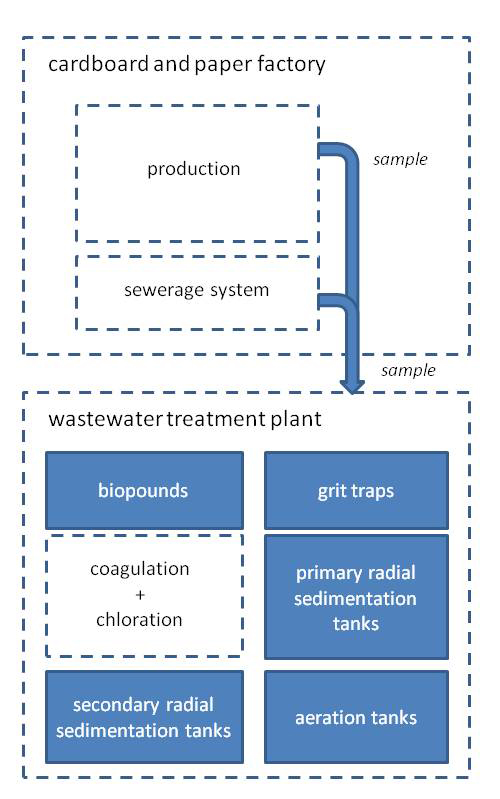Efficiency of physical-chemical treatment of wastewater of the paper and cardboard factory Scientific paper
Main Article Content
Abstract
The purpose of the work is to study the wastewater treatment of a cardboard and paper factory in the Khmelnytskyi region using physico-chemical methods, namely coagulation and oxidation, to increase the efficiency of removing organic pollutants according to COD and BOD indicators. The use of coagulation and chlorination methods, before biological treatment in aeration tanks, was proposed. Alumofloc 18% was used as a coagulant, PAA was used as a flocculant, and sodium hydroxide was used as an alkalizing reagent. The study was conducted on a mixture of industrial and sewage wastewater with COD and BOD5 – 3200 and 1575 mg L–1, respectively, and on industrial wastewater with COD and BOD5 – 4480 and 1960 mg L–1, respectively. The effects of reducing COD and BOD5 indicators in the first case after coagulation were 30 and 40%, after chlorination – 37.82 and 43.18%, respectively, and in the second after coagulation – 28.58 and 47.25%, respectively. The effects of wastewater treatment of a cardboard and paper factory using coagulation and oxidation methods will allow for a reduction in the concentration of organic substances according to COD and BOD indicators before the biological treatment of wastewater in aeration tanks and also will ensure an increase in the efficiency of biological treatment.
Downloads
Metrics
Article Details

This work is licensed under a Creative Commons Attribution 4.0 International License.

Authors retain copyright and grant the journal right of first publication with the work simultaneously licensed under a Creative Commons Attribution license 4.0 that allows others to share the work with an acknowledgement of the work's authorship and initial publication in this journal.
References
The "Global Paper Packaging Market: Growth, Trends, Competitive Landscape, and Forecasts" report , GLOBE NEWSWIRE, Dublin, Ireland, 2020.
M. A. Hubbe, J. R. Metts, D. Hermosilla, M. A. Blanco, L. Yerushalmi, F. Haghighat, P. Lindholm-Lehto, Z. Khodaparast, M. Kamali, A. Elliott, BioRes. 11 (2016) 7953 (https://doi.org/10.15376/biores.11.3.Hubbe)
O. Ashrafi, L. Yerushalmi, F. Haghighat, J. Environ. Manage. 158 (2015) 146 (https://doi.org/10.1016/j.jenvman.2015.05.010)
K. Eskelinen, H. Särkkä, N. A. Kurniawan, M. E. T. Sillanpää, Desalination 255 (2010) 179 (https://doi.org/10.1016/j.desal.2009.12.024)
N. Kishimoto, T. Nakagawa, H. Okada, H. Mizutani, J. Water Environ. Technol. 8 (2010) 99 (https://doi.org/10.2965/jwet.2010.99)
W. De los Santos Ramosa, T. Poznyaka, I. Chairez, I. Córdova, J. Hazard. Mater. 169 (2009) 428 (https://doi.org/10.1016/j.jhazmat.2009.03.152)
S. Kakkar, A. Malik, S. Gupta, J. Appl. Nat. Sci. 10 (2018) 695 (https://doi.org/10.31018/jans.v10i2.1769)
C. Ram, P. Rani, K.A. Gebru, Phys. Sci. Rev. 5 (2020) 8 (https://doi.org/10.1515/psr-2019-0050)
P. Singh, A. Srivastava, Int. J. Pharm. Bio. Sci. 5 (2014) 773 (https://api.semanticscholar.org/CorpusID:98160371)
M. Cabrera, A. Zaki , Pulp Mill Wastewater: Characteristics and Treatment, in Biological Wastewater Treatment and Resource Recovery, F. Robina, A. Zaki, (Eds), InTech, 2017, p. 256 (https://doi.org/10.5772/62795)
A. Schnell, P. V. Hodson, P. Steel, H. Melcer, J. H. Carey, Water Research 34 (2000) 501 (https://doi.org/10.1016/S0043-1354(99)00161-X)
C. W. Bryant, Water Sci. Technol. 62 (2010) 1248 (https://doi.org/10.2166/wst.2010.934)
C. V. Dubeski, R. M. Branion, K. V. Lo, J. Environ. Sci. Health. 36 (2001) 1245 (https://doi.org/10.1081/ese-100104875)
M. Tielbaard, T. Wilson, E. Feldbaumer, W. Driessen, Full-scale anaerobic treatment experiences with pulp mill evaporator condensates, in TAPPI International Environmental Conference, (2002), TAPPI Press, Atlanta, 2002, p. 621-634
L. Habets, W. Driessen, Water Sci. Technol. 55 (2007) 223 (https://doi.org/10.2166/wst.2007.232)
N. B. Golub, M. V. Potapova, Yu. V. Karpenko, IBB 3 (2019) 96 (https://doi.org/10.20535/ibb.2019.3.2.166429)
N.B. Golub, M.V. Shinkarchuk, O.A. Kozlovets, B. V. Morgun, O. R. Lakhneko, A. I. Stepanenko, M. V. Borisjuk, Water Air Soil Pollut. 231 (2020) 445 (https://doi.org/10.1007/s11270-020-04805-6)
R. Chhotu, R. Pushpa, G. A. Kibrom, M. G. M. Abrha, ,Phys. Sci. Rev. 5 (2020) 20190050 (https://doi.org/10.1515/psr-2019-0050)
M. A. Hubbe, J. R. Metts, D. Hermosilla, M. A. Blanco, L. Yerushalmi, F. Haghighat, P. Lindholm – Lehto, Z. Khodaparast, M. Kamali, A. Elliott, BioRes. 11 (2016) 7953 (https://doi.org/10.15376/biores.11.3.hubbe)
S. R. Hassan, N. Q. Zaman, I. Dahlan, Prep. Biochem. Biotechnol. 50 (2019) 234 https://doi.org/10.1080/10826068.2019.1692214).





